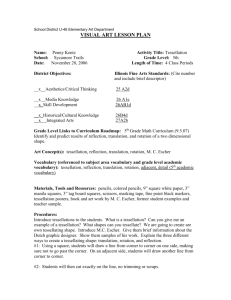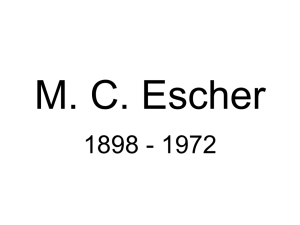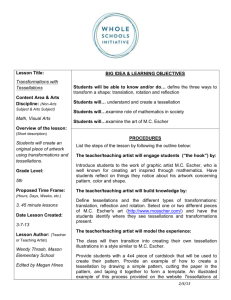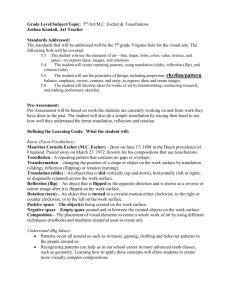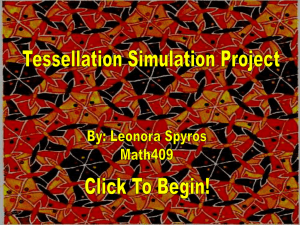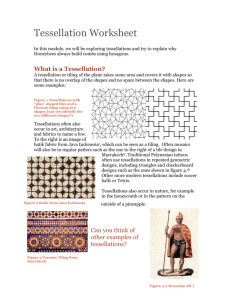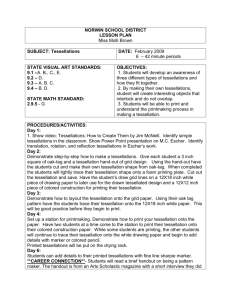tessellation3
advertisement
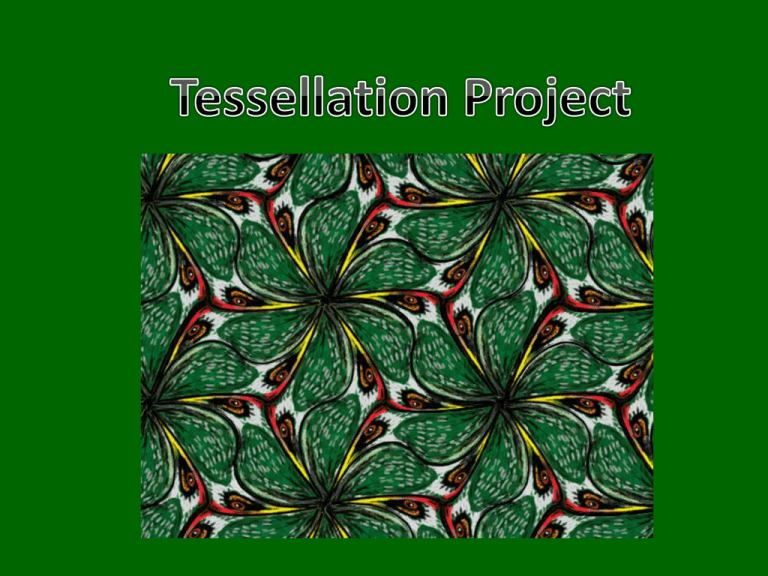
What is a tessellation? • A tessellation is a pattern of repeating figures that fit together with NO overlapping or empty spaces. • Tessellations are formed using transformation. • Transformations: – Translation** – Rotation** – Reflection** – Dilation Examples of Tessellation Art More examples of Tessellation Artists • http://tessellations.org/index.htm Project Directions 1. Start with a template piece – Must be a REGULAR polygon (squares work well) 2. Choose one of the following transformations – – – – 3. 4. 5. 6. Translation Glide Reflection (translation with reflection) Rotation Mid-point Rotation Practice with template on computer paper. Trace your final product on to white card stock (9x12). Color and decorate Mount onto construction paper Translation Tessellation (EASY) For simple translation tessellations, your starting polygon should have opposite sides that are parallel and congruent. Squares, hexagons, and parallelograms work best. Translation Tessellation (HARD) You can create more complex designs starting with square tessellations and making changes on both pairs of sides. 1. 2. 3. 4. Start with a square Draw a design on one side of the square and slide it to opposite side. Draw another design on the adjacent side of the square and slide it to opposite side. Tape the cutout pieces to opposite sides. Slide (translation) the pattern when tracing. Depending how you decide to color your tessellation, a very simple design can have a very creative result. Glide Reflection Tessellation For glide reflection tessellations, your polygons should have opposite sides that are parallel and congruent. Squares, hexagons, and parallelograms work best. *You can make this one more difficult by cutting out two pieces from different sides and doing a glide reflection for both. Rotation Tessellation For rotation tessellations, the adjacent sides of the polygon must be congruent. Squares, equilateral triangles, regular hexagons, and rhombi work best. *You can make this one more difficult by cutting out two pieces from different sides and doing a rotation tessellation for both. Midpoint Rotation Tessellations • Triangles, squares, and quadrilaterals work best for this type. *You can make this one more difficult by cutting out two pieces from different sides and doing a mid-point rotation for both. Example: Rotational Tessellation Grade Criteria Degree of Difficulty The difficulty and intricacy of the template you made and the difficulty of the type of transformation you choose. Complexity of Decoration The detail, coloring and creativity of your final product. Appearance Figured must be centered, no stray marks showing, no blank space, and final product should be mounted on construction paper. Proper Transformation Used A correct use of translation, glide reflection, rotation or mid-point rotation must be used. Followed Directions On the front of you final product you must give your artwork a title, your name and type of Excellent Good Okay Not done 10 9 8 2 cut-outs 7 6 5 4 2 or 1 cut-outs 3 2 1 1cut-out 0 10 9 8 7 6 5 4 3 2 1 0 10 9 8 7 6 5 4 3 2 1 0 10 9 8 7 6 5 4 3 2 1 0 10 9 8 7 6 5 4 3 2 1 0
